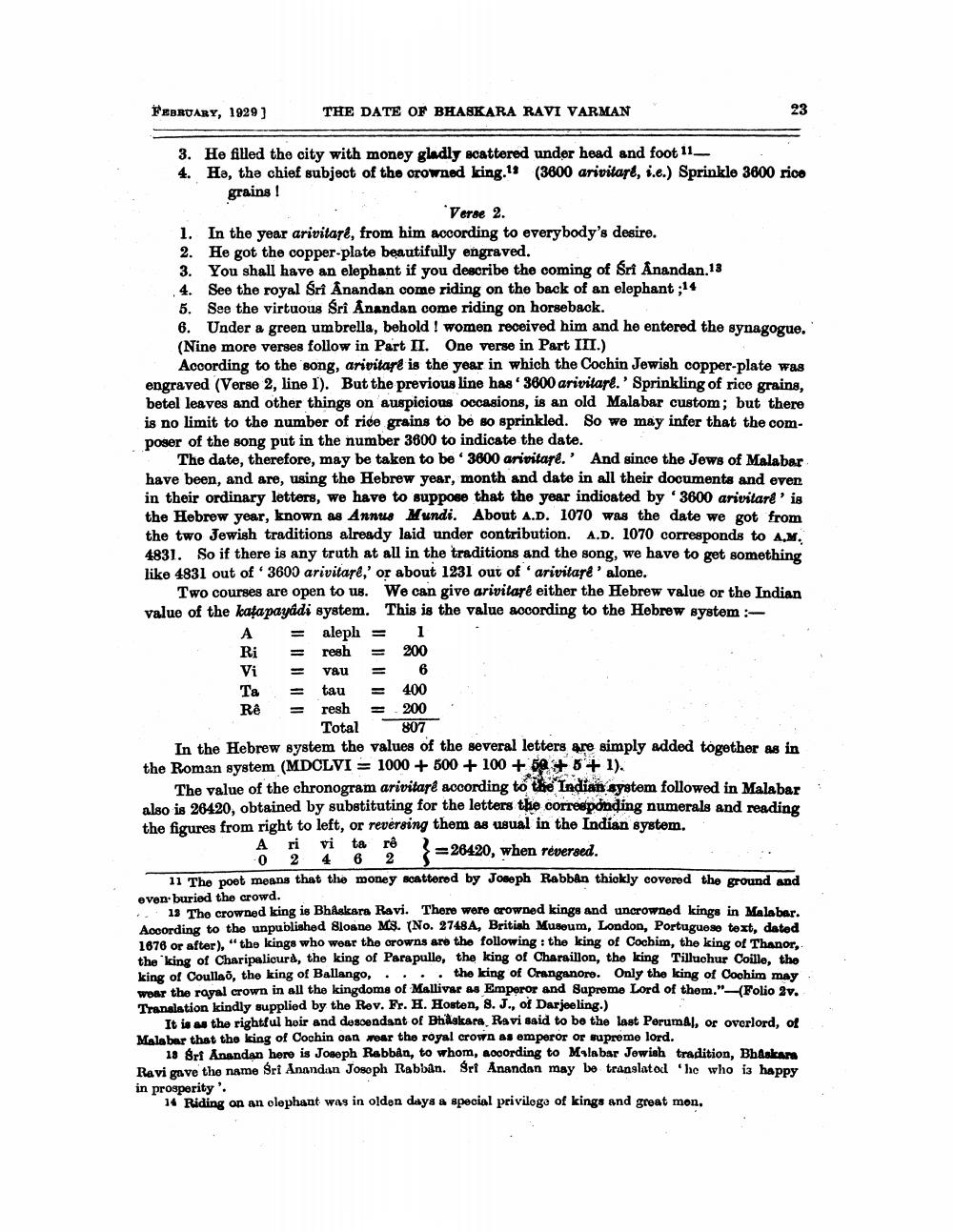________________
FEBRUARY, 1929 ]
THE DATE OF BHASKARA RAVI VARMAN
3. He filled the city with money gladly scattered under head and foot 114. Ha, the chief subject of the crowned king. 18 (3800 arivitare, i.e.) Sprinkle 3600 rice
grains!
A
Verse 2. 1. In the year arivitaté, from him according to everybody's desire. 2. He got the copper-plate beautifully engraved. 3. You shall have an elephant if you describe the coming of Sri Anandan.13 4. See the royal Sri Anandan come riding on the back of an elephant ;14 5. See the virtuous Sri Anandan come riding on horseback. 6. Under a green umbrella, behold! women received him and he entered the synagogue. (Nine more verses follow in Part II. One verse in Part III.)
According to the song, arivitare is the year in which the Cochin Jewish copper-plate was engraved (Verse 2, line 1). But the previous line has3600 arivitase.' Sprinkling of rice grains, betel leaves and other things on auspicious occasions, is an old Malabar custom; but there is no limit to the number of rice grains to be so sprinkled. So we may infer that the composer of the song put in the number 3800 to indicate the date.
The date, therefore, may be taken to be .3800 arivitasé.' And since the Jews of Malabar have been, and are, using the Hebrew year, month and date in all their documents and even in their ordinary letters, we have to suppose that the year indicated by 3600 arivitare'is the Hebrew year, known as Annus Mundi. About A.D. 1070 was the date we got from the two Jewish traditions already laid under contribution. A.D. 1070 corresponds to A.M. 4831. So if there is any truth at all in the traditions and the song, we have to get something like 4831 out of 3600 arivitare,' or about 1231 out of 'arivitaré' alone.
Two courses are open to us. We can give arivitare either the Hebrew value or the Indian value of the kata payádi system. This is the value according to the Hebrew system :
= aleph = 1 Ri = resh = 200 Vi = 81 = 6
= tau = 400
resh = 200 .
Total 807 In the Hebrew system the values of the several letters are simply added together as in the Roman system (MDCLVI = 1000 + 500 + 100 + 50+ 5 + 1).
The value of the chronogram arivitaré according to the Indian system followed in Malabar also is 26420, obtained by substituting for the letters the corresponding numerals and reading the figures from right to left, or reversing them as usual in the Indian system. A
t a 9 =26420, when reversed.
0 2 4 6 2 11 The poet means that the money scattered by Joseph Rabban thickly covered the ground and even: buried the crowd.
13 The crowned king is BhAskars Ravi. There were crowned kings and uncrowned kings in Malabar. According to the unpublished Sloane MS. (No. 2748A, British Museum, London, Portuguese toxt, dated 1676 or after), "the kings who wear the crowns are the following: the king of Cochim, the king of Thanor, the king of Charipaliour, the king of Parapulle, the king of Charaillon, the king Tilluohur Coille, the king of Coullao, the king of Ballango,.... the king of Cranganore. Only the king of Cochim may woar the rayal crown in all the kingdoms of Mallivar as Emperor and Supreme Lord of thom."-(Folio 2v. Translation kindly supplied by the Rev. Fr. H. Hoston, 8. J., of Darjeeling)
It is the rightful hair and descendant of Bhaskara Ravi said to be the last Perumal, or overlord, of Malabar that the king of Cochin oan wear the royal crown as emperor or supremo lord.
19 gr Anandan here is Joseph Rabban, to whom, according to Malabar Jowish tradition, Bhaskar Ravi gave the name Sri Anandan Joseph Rabban. Sri Anandan may be translato 'ho who is happy in prosperity
14 Riding on an elephant was in olden days a special privilege of kings and great mon,
Re




